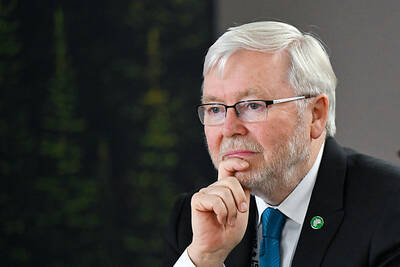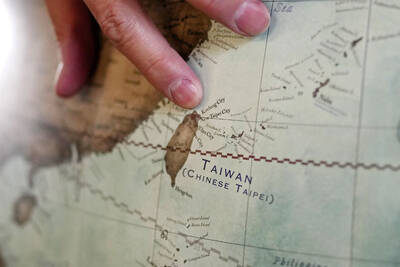There is a deafening, unearthly howl as if a jumbo jet was firing up its engines in London's Albert Hall. On the screen in the control room a ghostly pinkish glow whips round the edges of the inside of the nuclear reactor. At its core it is 10 times hotter than the center of the sun.
This, according to some physicists, is the solution to the energy crisis -- a future with cheap, reliable, safe and nearly waste-free power. Today, after years of false starts and political wrangling dating from the Cold War, they will get their chance to make that dream a reality. A 10 billion euro (US$12.74 billion) project, called Iter, to build a prototype nuclear fusion reactor will be signed off in Brussels by the EU, Japan, China, South Korea, India and the US.
The prospect of virtually limitless energy is not merely science fiction. The haunting, screaming growl of matter being smashed together at unimaginably high speed is a daily occurrence at Jet in Oxfordshire, an existing experimental fusion reactor. Jet is by far the biggest of the world's 28 fusion reactors. It is the work of scientists here that has paved the way for the much bigger Iter, which, once the project is ratified in December, will be built in Cadarache in southern France.
Its advocates say nuclear fusion is the most promising long-term solution to the energy crisis, offering the possibility of abundant power from cheap fuel with no greenhouse gases and low levels of radioactive waste. But critics say the UK government is gambling huge sums of money -- 44 percent of it's research and development budget for energy -- on a long shot with no guarantee of ever producing useful energy.
Last week British Prime Minister Tony Blair backed conventional nuclear power, saying in a speech to business leaders that not replacing Britain's aging nuclear power stations would be "a serious dereliction of our duty to the future of this country."
He argued that only nuclear energy could prevent a huge hike in CO2 emissions once the current nuclear stations were decommissioned.
But while the debate over the future of conventional nuclear power continues, many physicists argue that fusion is the future.
"Fusion works -- it powers the sun and stars," said Sir Chris Llewellyn Smith, head of the UK Atomic Energy Authority. "In the second part of the century I'm optimistic it will indeed be a major part of the world energy portfolio."
Unlike nuclear fission, which tears atomic nuclei apart to release energy, fusion involves squeezing the nuclei of two hydrogen atoms together. This process releases a helium nucleus and a neutron plus huge quantities of energy. The hydrogen fuel is part heavy hydrogen or deuterium, which can be easily extracted from water, and part super-heavy hydrogen or tritium, which can be made from lithium, a reasonably abundant metal.
The energy produced is truly colossal. The lithium in just one laptop battery and the heavy hydrogen from half a bath of water could provide enough energy for the average European for 30 years.
One of fusion's big advantages over fission is safety. Firstly, there is no chance of a runaway meltdown as happened at Chernobyl. If you stop applying the fuel or switch off the magnetic jacket that keeps the fuel in the reactor, the reaction just stops.
"It is very difficult to keep it running. It is like keeping honey on the back of a spoon," said Mathias Brix, a physicist at Jet.
Also, the quantities of fuel involved are much smaller than in fission reactors. Jet contains less than a gram of fuel, while Chernobyl had 250 tonnes. Lastly, the fuel and waste from the reactor is much less radioactive. But although physicists think they understand fusion, harnessing it has proved extremely difficult.
Research first began in the 1950s with claims that fusion would provide reliable power by the end of the century but even now scientists admit that a commercial application is at least 40 years away. The problem is getting two nuclei close enough to fuse and then controlling the reaction. This means putting in huge amounts of energy at the start to convert less than a gram of the fusion fuel into a super-hot gas or plasma. Hydrogen nuclei flying around at high speed in the plasma can then come close enough together to fuse.
In 1991 Jet was the first fusion reactor to do this using a mixture of deuterium and tritium. It proved that fusion reactors could work, but was not a viable energy option because it only pumped out about 70 percent of the energy required to start the process off.
"The purpose of these experiments is not really to produce energy but to learn how to control the hot gas," Smith said.
Iter will be 10 times the volume of Jet and produce 10 times the energy needed to get the reaction started.
"It's the step where we will demonstrate scientifically and technically that fusion energy is a viable energy source," said Akko Mass, one of the Iter scientists.
But with so many broken promises some involved in the project doubt it will yield commercial energy any time soon. Iter scientist John How described the billed 40-year timescale as "very, very, very ambitious." He suspects it will be nearer to a century.

NEXT GENERATION: The four plants in the Central Taiwan Science Park, designated Fab 25, would consist of four 1.4-nanometer wafer manufacturing plants, TSMC said Taiwan Semiconductor Manufacturing Co (TSMC, 台積電) plans to begin construction of four new plants later this year, with the aim to officially launch production of 2-nanometer semiconductor wafers by late 2028, Central Taiwan Science Park Bureau director-general Hsu Maw-shin (許茂新) said. Hsu made the announcement at an event on Friday evening celebrating the Central Taiwan Science Park’s 22nd anniversary. The second phase of the park’s expansion would commence with the initial construction of water detention ponds and other structures aimed at soil and water conservation, Hsu said. TSMC has officially leased the land, with the Central Taiwan Science Park having handed over the

AUKUS: The Australian Ambassador to the US said his country is working with the Pentagon and he is confident that submarine issues will be resolved Australian Ambassador to the US Kevin Rudd on Friday said that if Taiwan were to fall to China’s occupation, it would unleash China’s military capacities and capabilities more broadly. He also said his country is working with the Pentagon on the US Department of Defense’s review of the AUKUS submarine project and is confident that all issues raised will be resolved. Rudd, who served as Australian prime minister from 2007 to 2010 and for three months in 2013, made the remarks at the Aspen Security Forum in Colorado and stressed the longstanding US-Australia alliance and his close relationship with the US Undersecretary

‘WORLD WAR III’: Republican Representative Marjorie Taylor Greene said the aid would inflame tensions, but her amendment was rejected 421 votes against six The US House of Representatives on Friday passed the Department of Defense Appropriations Act for fiscal 2026, which includes US$500 million for Taiwan. The bill, which totals US$831.5 billion in discretionary spending, passed in a 221-209 vote. According to the bill, the funds for Taiwan would be administered by the US Defense Security Cooperation Agency and would remain available through Sept. 30, 2027, for the Taiwan Security Cooperation Initiative. The legislation authorizes the US Secretary of Defense, with the agreement of the US Secretary of State, to use the funds to assist Taiwan in procuring defense articles and services, and military training. Republican Representative

TAIWAN IS TAIWAN: US Representative Tom Tiffany said the amendment was not controversial, as ‘Taiwan is not — nor has it ever been — part of Communist China’ The US House of Representatives on Friday passed an amendment banning the US Department of Defense from creating, buying or displaying any map that shows Taiwan as part of the People’s Republic of China (PRC). The “Honest Maps” amendment was approved in a voice vote on Friday as part of the Department of Defense Appropriations Act for the 2026 fiscal year. The amendment prohibits using any funds from the act to create, buy or display maps that show Taiwan, Kinmen, Matsu, Penghu, Wuciou (烏坵), Green Island (綠島) or Orchid Island (Lanyu, 蘭嶼) as part of the PRC. The act includes US$831.5 billion in